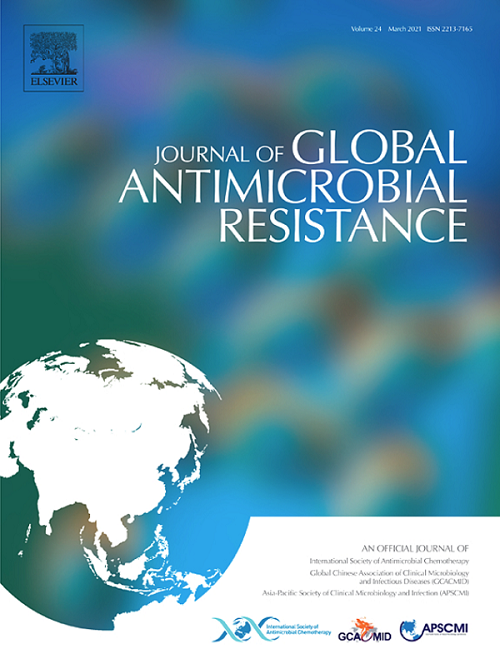Minimum inhibitory concentration distribution of Mecillinam in clinical Staphylococcus saprophyticus isolates from Europe
IF 3.7
3区 医学
Q2 INFECTIOUS DISEASES
引用次数: 0
Abstract
Objectives
Staphylococcus saprophyticus (S. saprophyticus) is the second most common bacteria causing uncomplicated urinary tract infections (UTIs). It is considered non-susceptible to mecillinam, with no defined breakpoint and only few available minimal inhibitory concentration (MIC) observations. However, this consideration does not correlate with clinical outcome. With this study, we aimed to provide a comprehensive MIC distribution analysis of mecillinam for S. saprophyticus, which could be useful for determining potential breakpoints.
Methods
We studied 112 isolates of S. saprophyticus from human urine samples from 4 European countries. The broth microdilution and MIC test strip methods were used to determine mecillinam MIC.
Results
Broth microdilution MICs ranged from 4 to ≥ 256 mg/L, with a binary clustering at 32 to 64 and ≥ 256 mg/L. The MICs were duplicated for each isolate with similar results. The MIC distribution from the test strip method aligned well with the results from the broth microdilution method. Disc diffusion test yielded an 8 mm inhibitory zone in three isolates with MIC of 32 mg/L.
Conclusions
Considering mecillinam concentration in the urine usually reach 200 mg/L in conventional treatment, the clinical success frequently seen with pivmecillinam treatment for UTIs caused by S. saprophyticus may be explained by the MIC cluster of 32 to 64 mg/L. This cluster might be identified by an 8 mm inhibitory zone in disc diffusion tests. Clinical studies with MIC data are needed to examine potential breakpoints. As of now, clinicians should not switch empirical pivmecillinam treatment to other antibiotics based solely on the presence of S. saprophyticus. © 2025 The Author(s). Published by Elsevier Ltd on behalf of International Society for Antimicrobial Chemotherapy.
美西利南在欧洲临床腐生葡萄球菌分离株中的最低起始浓度分布。
背景:腐生葡萄球菌是引起非复杂性尿路感染(UTI)的第二常见细菌。它被认为对美西利南不敏感,没有定义的断点,只有少数可用的最小抑制浓度(MIC)观察结果。然而,这种考虑与临床结果并不相关。通过这项研究,我们旨在提供一个全面的美西林对腐生葡萄球菌的MIC分布分析,这可能有助于确定潜在的断点。材料/方法:从欧洲4个国家的人尿液中分离出112株腐生葡萄球菌。采用微量肉汤稀释法和MIC试纸条法测定美西林的MIC。结果:肉汤微量稀释mic范围为4 ~≥256 mg/L,在32 ~ 64和≥256 mg/L呈二元聚类。对每个分离物重复MIC,结果相似。试验条法所得的MIC分布与肉汤微量稀释法所得的结果一致。膜片扩散试验对3株分离菌的抑菌带为8 mm, MIC为32 mg/L。结论:考虑到常规治疗时美西利南尿中浓度通常达到200 mg/L,哌美西利南治疗腐生链球菌所致尿路感染的临床成功可能与32 ~ 64 mg/L的MIC簇有关。在椎间盘扩散试验中,可以通过一个8毫米的抑制带来识别这个簇。需要有MIC数据的临床研究来检查潜在的断点。到目前为止,临床医生不应该仅仅基于腐生葡萄球菌的存在而将经验性哌美西林治疗转换为其他抗生素。
本文章由计算机程序翻译,如有差异,请以英文原文为准。
求助全文
约1分钟内获得全文
求助全文
来源期刊

Journal of global antimicrobial resistance
INFECTIOUS DISEASES-PHARMACOLOGY & PHARMACY
CiteScore
8.70
自引率
2.20%
发文量
285
审稿时长
34 weeks
期刊介绍:
The Journal of Global Antimicrobial Resistance (JGAR) is a quarterly online journal run by an international Editorial Board that focuses on the global spread of antibiotic-resistant microbes.
JGAR is a dedicated journal for all professionals working in research, health care, the environment and animal infection control, aiming to track the resistance threat worldwide and provides a single voice devoted to antimicrobial resistance (AMR).
Featuring peer-reviewed and up to date research articles, reviews, short notes and hot topics JGAR covers the key topics related to antibacterial, antiviral, antifungal and antiparasitic resistance.
 求助内容:
求助内容: 应助结果提醒方式:
应助结果提醒方式:


